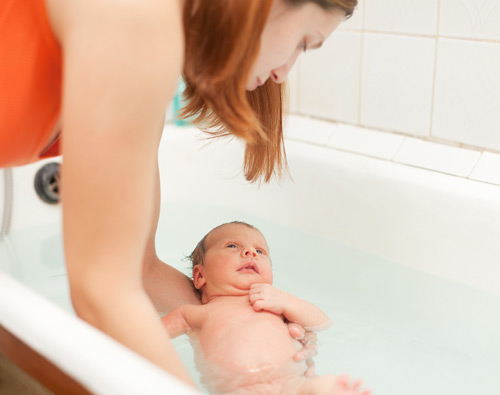Bathing Your Baby

There's no need to give your newborn a bath every day. In fact, bathing your baby more than several times a week may dry out his or her skin. If you're quick with clean diapers and fresh burp cloths, you're already cleaning the parts that really need attention - the face, neck and diaper area. 3 or 4 baths per-week should be sufficient, with adherence to the following guidelines:
- Wash from face down to the toes. Use a clean edge of the washcloth to cleanse around each eye. Wipe from the center of the nose out toward the cheeks in a soft sweeping motion.
- For girls, gently wash the inside of the labia by wiping down toward the buttocks, and use a clean part of the washcloth for each side.
- For boys, wash gently around the foreskin, down the penis, and around and under the scrotum.
- Plain water is fine for newborns. When needed, use a mild, unscented soap with a moisturizer. Avoid bubble bath.
- Rinse the soap off well. A redness of the skin may occur if soap is not fully rinsed.
- Shampooing can be done 2 or 3 times a week, with baby shampoo.
- Use a tearless shampoo (only a small amount) and rinse well. Scrub lightly to loosen any skin build-up.
- Wrap and dry your baby with a soft towel & dry her thoroughly.
- Towel dry the hair, then brush it with a soft-bristled baby brush.
Note: Even if your baby doesn't have much hair, brush it every day to stimulate hair growth and prevent dry scalp, or "cradle cap".
- Don't use powder. It can enter your baby's lungs and make him sick.
- Lotion is OK to use, but only after your baby's skin is very dry. (In fact, greasy lotions or ointments may make a rash more likely by blocking your baby's tiny sweat glands.) The best way to prevent rashes is to dry inside your baby's folds of skin after each bath.
Preparing the tub
You'll need only a few inches of warm water. (Warm water is best. To prevent scalding, set the thermostat on your water heater to below 120 F. Always check the temperature with your hand before bathing your baby.) Keep room temperature in mind as well. A wet baby may be easily chilled. Be sure the room is comfortably warm - about 75 F.
Note: At first, you may want to lather your baby on a towel and use the tub only for rinsing
Slippery When Wet
Bathing a slippery newborn can be a nerve-racking experience. Your baby may not like it much, either. But stay calm, with a little practice you will both begin to feel more comfortable.
Washing a Newborn's Hair
Yes, if it seems dirty or your baby develops cradle cap, a common condition characterized by scaly patches on the scalp.
Supporting your baby's head and shoulders with your free hand, gently massage a drop of mild baby shampoo into his or her scalp. Rinse the shampoo with a damp washcloth. If your baby has cradle cap, loosen the scales with a small, soft-bristled brush before rinsing off the shampoo.
Tub Safety
Gather your supplies ahead of time so you can keep one hand on the baby at all times. If you're interrupted, take your baby with you. Never leave your baby alone in the water.
Holding Baby in the Tub
- To wash the front of your baby's body, support your baby's head and torso with your arm and hand.
- A secure hold will help your baby feel comfortable - and stay safe - in the tub.
- Support your baby's head and torso with your arm and hand. Wrap your arm under your baby's back, grasping your baby firmly under the armpit.
- When you clean your baby's back and buttocks, lean him or her forward on your arm. Continue to grasp your baby under the armpit.
- To rinse your baby's hair, try a football hold under the faucet. Support your baby's back with your arm, keeping a firm hold on the head while you rinse.
- To wash your baby's back and buttocks, lean him or her forward on your arm.
- To rinse your baby's hair, try a football hold under the faucet.
 PREGNANCY
PREGNANCY  GIVING BIRTH
GIVING BIRTH  BABY CARE
BABY CARE  HEALTH & SAFETY
HEALTH & SAFETY  FUN STUFF
FUN STUFF  FAMILY
FAMILY 